The Intel Optane Memory (SSD) Preview: 32GB of Kaby Lake Caching
by Billy Tallis on April 24, 2017 12:00 PM EST- Posted in
- SSDs
- Storage
- Intel
- PCIe SSD
- SSD Caching
- M.2
- NVMe
- 3D XPoint
- Optane
- Optane Memory
Sequential Read
Sequential access is usually tested with 128kB transfers, which is large enough that requests can typically be striped across multiple controller channels and still involve writing a full page or more to the flash on each channel. Real-world sequential transfer sizes vary widely depending on factors like which application is moving the data or how fragmented the filesystem is.
The drives were preconditioned with two full writes using 4kB random writes, so the data on each drive is entirely fragmented. This may limit how much prefetching of user data the drives can perform on the sequential read tests, but they can likely benefit from better locality of access to their internal mapping tables. These tests were conducted on the Optane Memory as a standalone SSD, not in any caching configuration.
Queue Depth 1
The test of sequential read performance at different transfer sizes was conducted at queue depth 1. Each transfer size was used for four minutes, and the throughput was averaged over the final three minutes of each test segment.
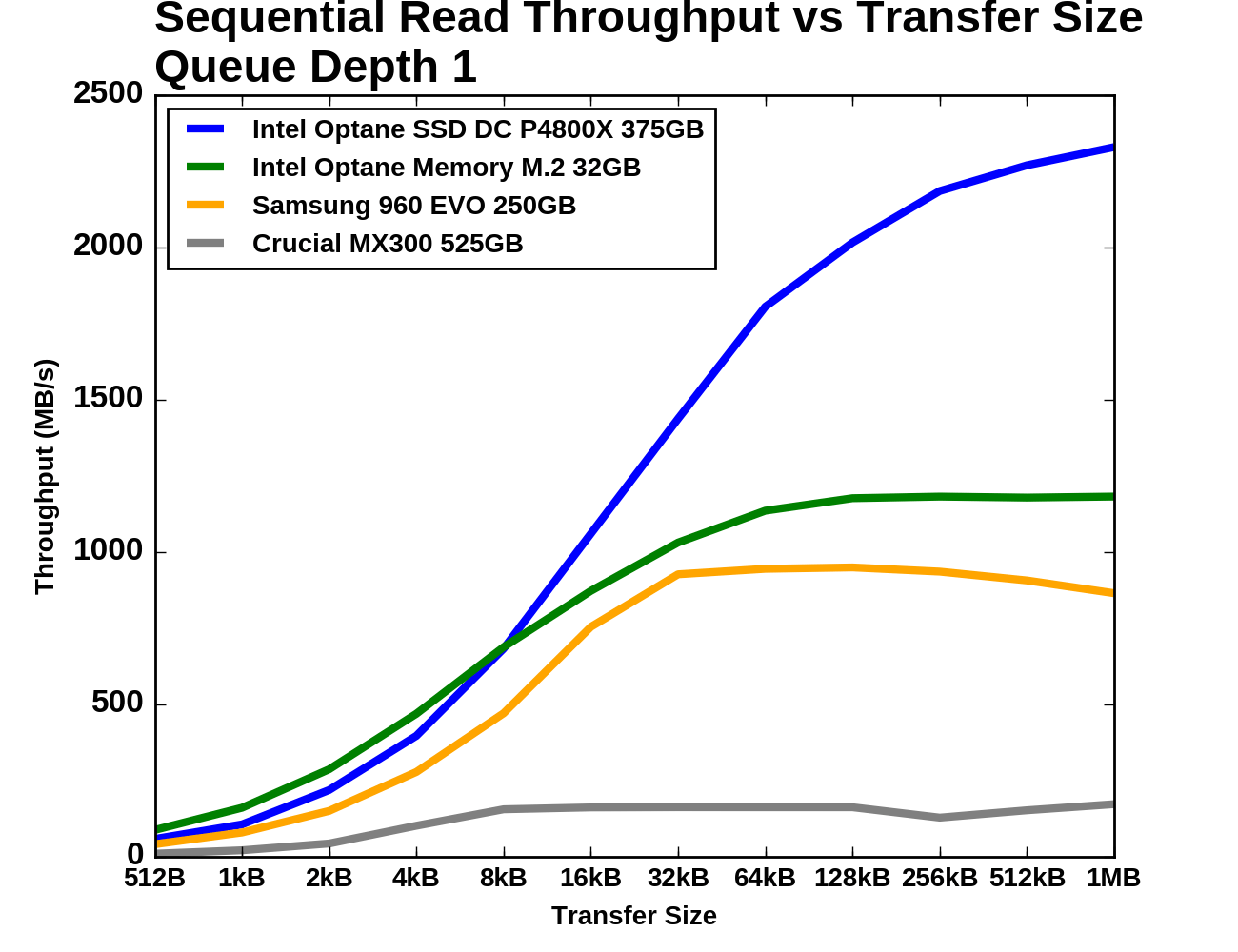 |
|||||||||
| Vertical Axis scale: | Linear | Logarithmic | |||||||
The three PCIe drives show similar growth through the small to mid transfer sizes, but the Optane Memory once again has the highest performance for small transfers and higher performance across the board than the Samsung 960 EVO.
Queue Depth > 1
For testing sequential read speeds at different queue depths, we use the same overall test structure as for random reads: total queue depths of up to 64 are tested using a maximum of four threads. Each thread is reading sequentially but from a different region of the drive, so the read commands the drive receives are not entirely sorted by logical block address.
The Samsung 960 EVO and Optane Memory start out with QD1 sequential read performance and latency that is relatively close, but then at higher queue depths the Optane Memory jumps up to a significantly higher throughput.
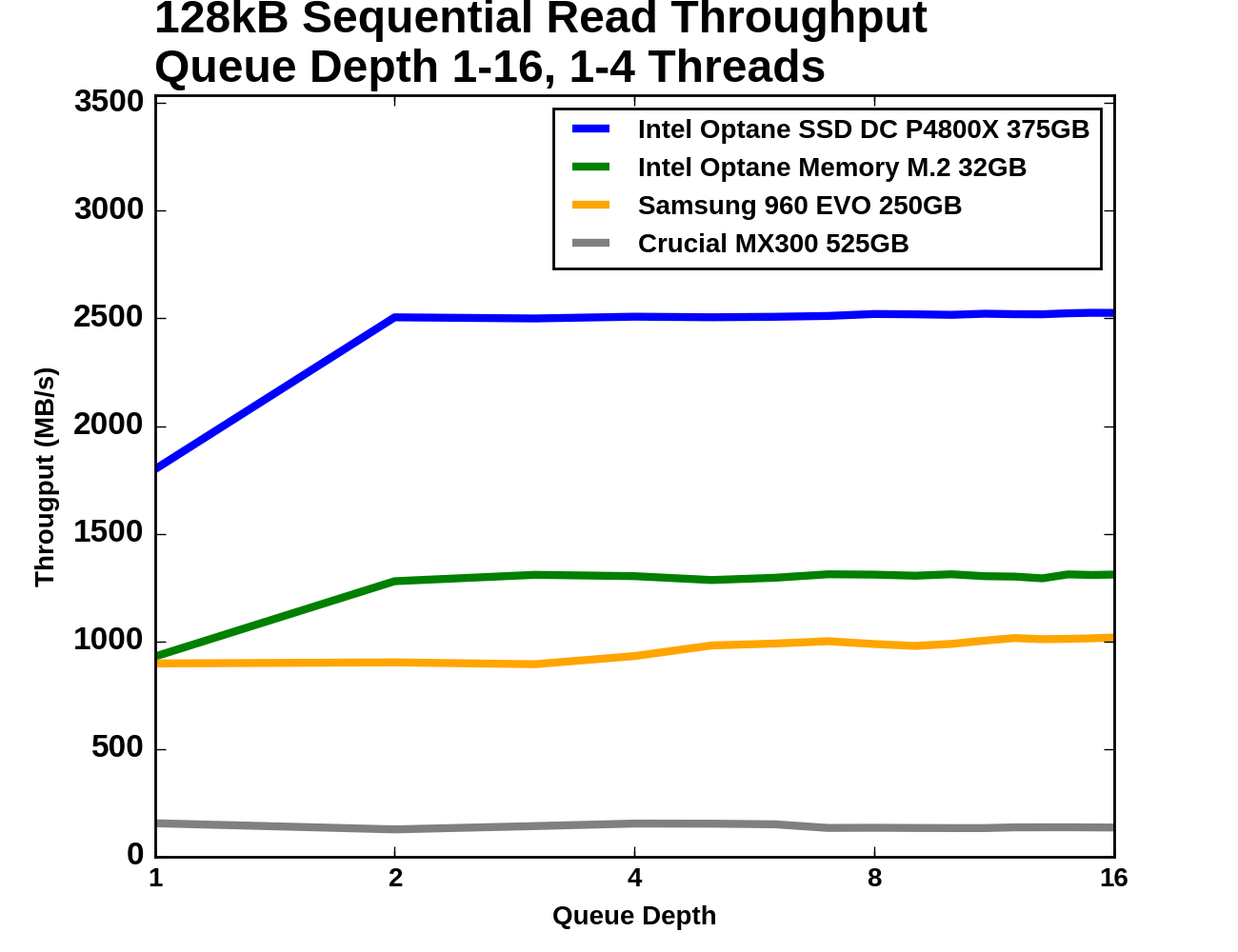 |
|||||||||
| Vertical Axis scale: | Linear | Logarithmic | |||||||
The two Optane devices saturate for sequential reads at QD2, but the Optane Memory experiences a much smaller jump from its QD1 throughput. The flash SSDs are mostly saturated from the start. The Crucial MX300 delivers far lower performance than SATA allows for, due to this test being multithreaded with up to four workers reading from different parts of the drive.
 |
|||||||||
| Mean | Median | 99th Percentile | 99.999th Percentile | ||||||
Since all four drives are saturated through almost all of this test, the latency graphs are fairly boring: increasing queue depth increases latency. For mean and median latency the Optane Memory and the Samsung 960 EVO are relatively close, but for the 99th and 99.999th percentile metrics the 960 EVO is mostly slower than the Optane Memory by about the same factor of two that the P4800X beats the Optane Memory by.
Sequential Write
The sequential write tests are structured identically to the sequential read tests save for the direction the data is flowing. The sequential write performance of different transfer sizes is conducted with a single thread operating at queue depth 1. For testing a range of queue depths, a 128kB transfer size is used and up to four worker threads are used, each writing sequentially but to different portions of the drive. Each sub-test (transfer size or queue depth) is run for four minutes and the performance statistics ignore the first minute. These tests were conducted on the Optane Memory as a standalone SSD, not in any caching configuration.
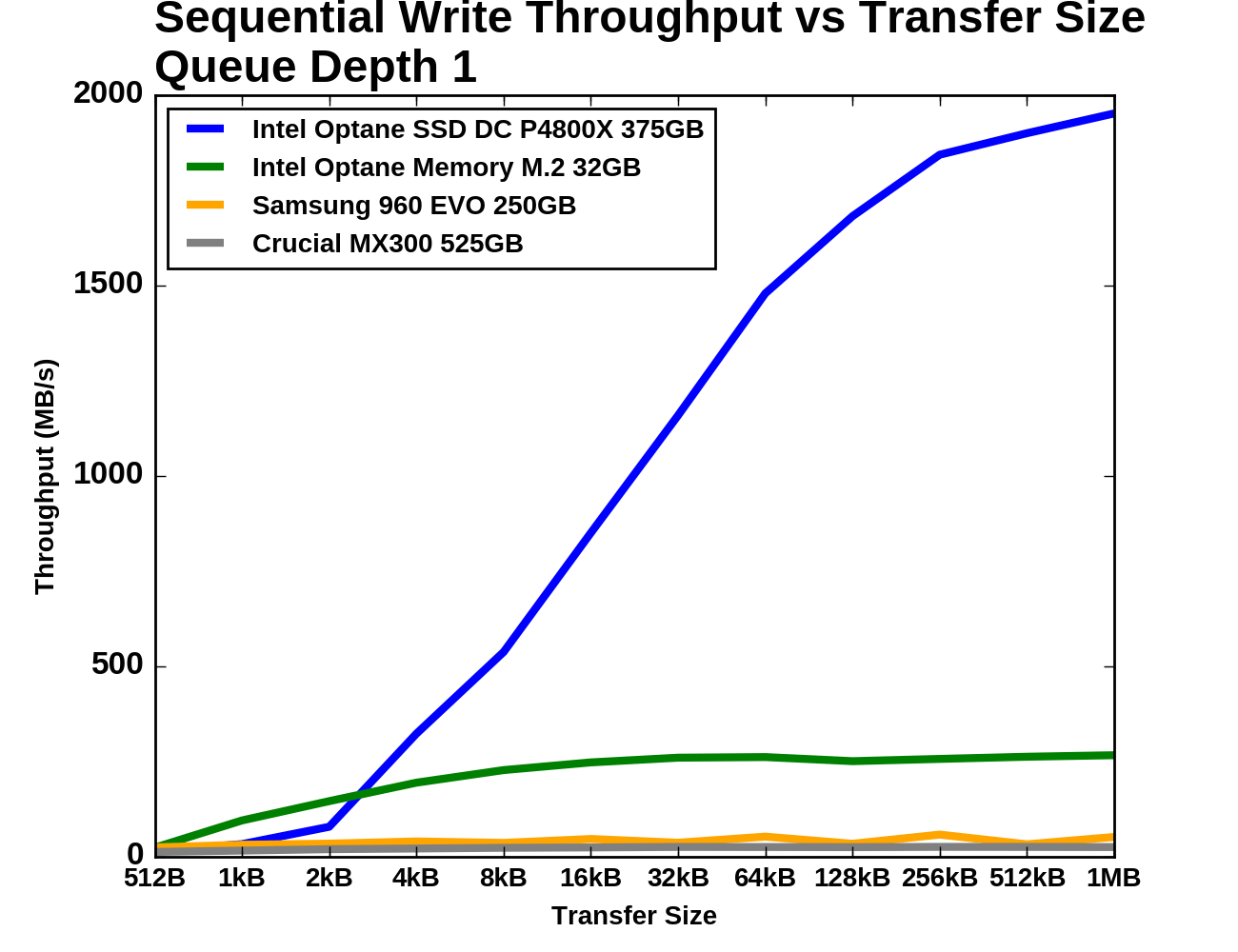 |
|||||||||
| Vertical Axis scale: | Linear | Logarithmic | |||||||
The enterprise-focused Optane SSD P4800X is slower than the consumer Optane Memory for sequential writes of less than 4kB, and even the Samsung 960 EVO beats the P4800X at 512B transfers. The 960 EVO's performance is inconsistent through the second half of the test but on average it is far closer to the MX300 than either Optane device. For larger transfers the MX300 is about a tenth the speed of the Optane Memory.
Queue Depth > 1
The sequential write throughput of the Optane SSD DC P4800X dwarfs that of the other three drives, even the Optane Memory. The Optane Memory does provide substantially higher throughput than the flash SSDs, but it does not have a latency advantage for sequential writes.
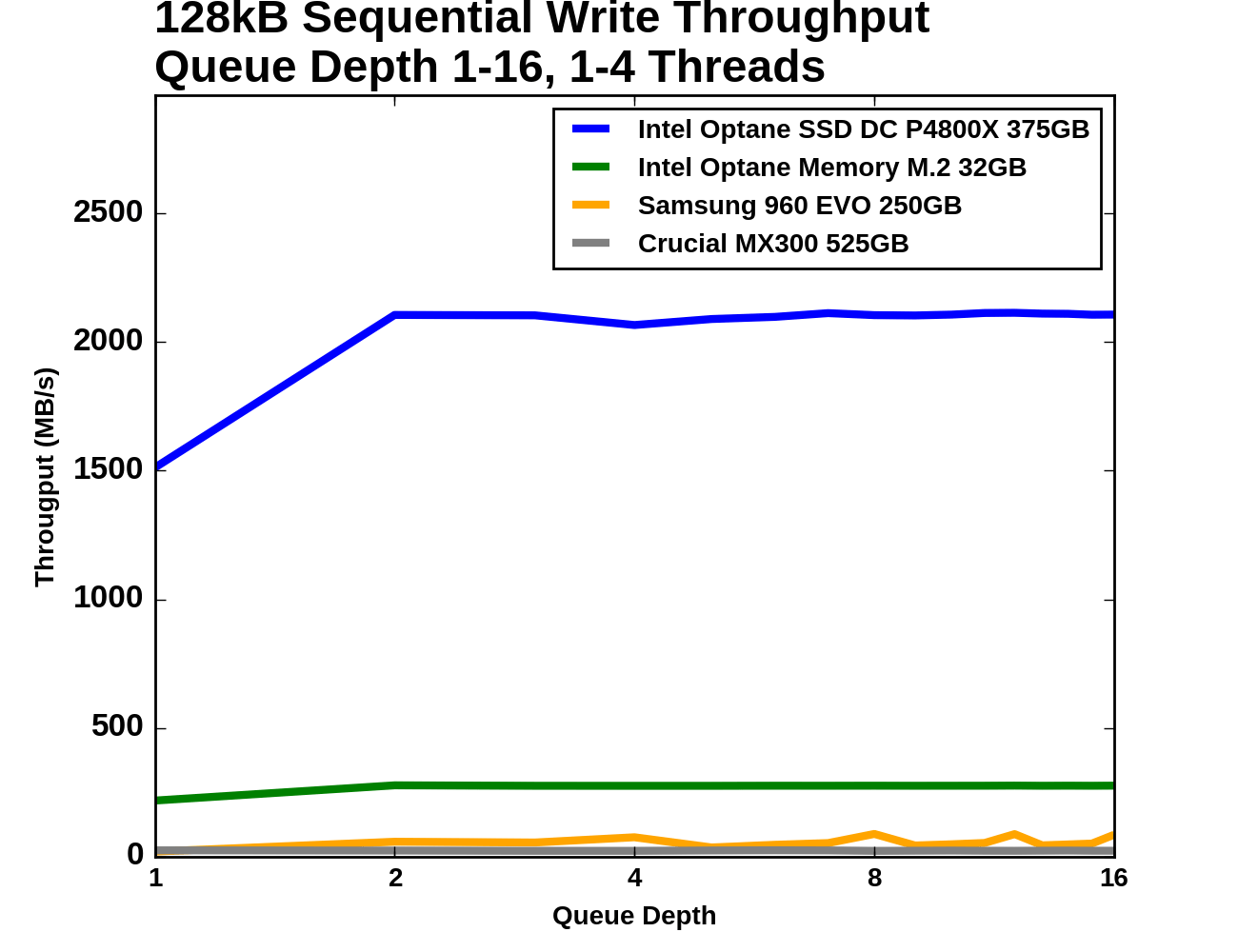 |
|||||||||
| Vertical Axis scale: | Linear | Logarithmic | |||||||
The Crucial MX300 is the only drive that does not get a throughput boost going from QD1 to QD2; as with the random write test it is not able to improve performance when the higher queue depth is due to multiple threads writing to the drive. The Samsung 960 EVO improves from the addition of a second thread but beyond that it simply gets more inconsistent. The Optane Memory and P4800X are both very consistent and saturated at QD2 after a moderate improvement from QD1.
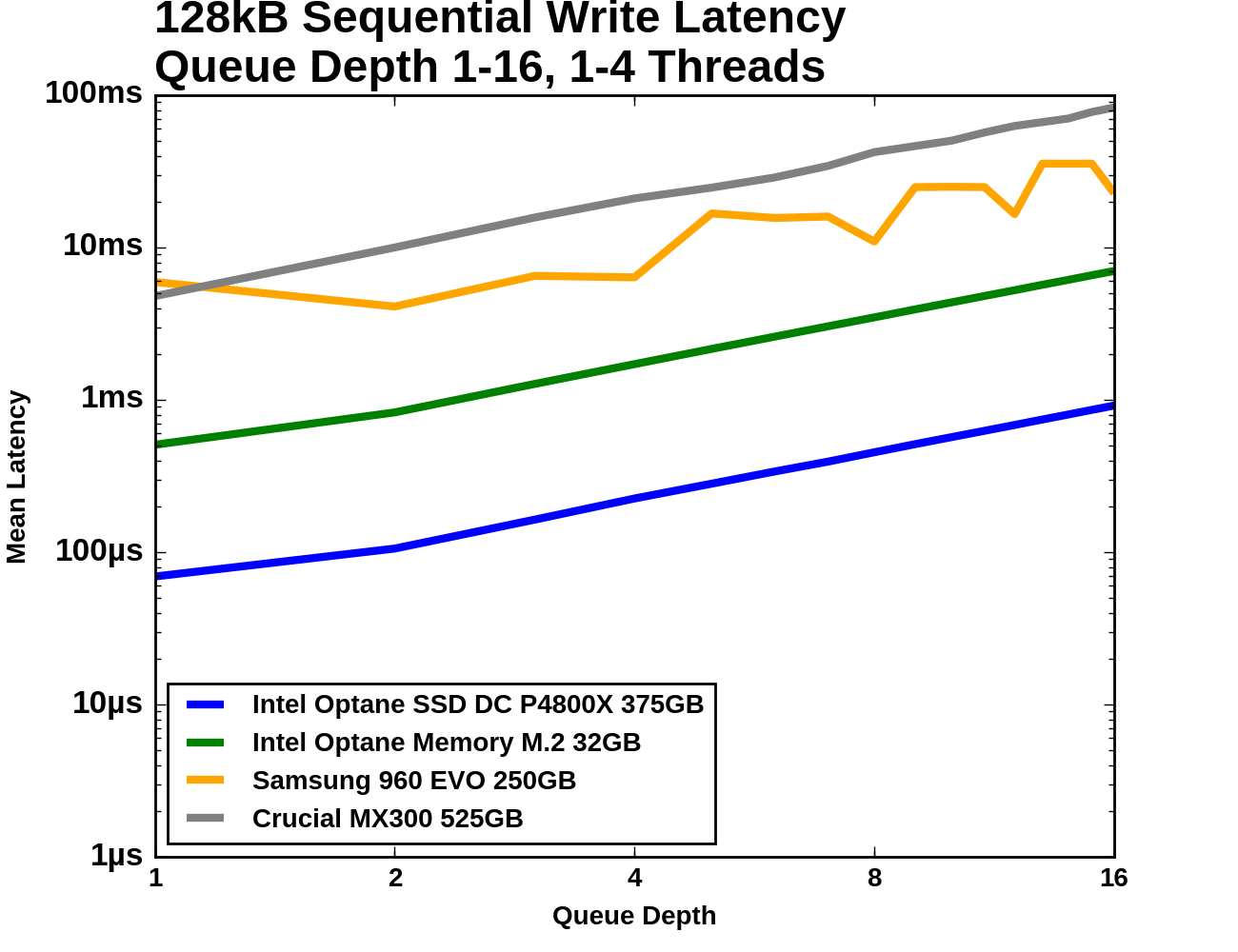 |
|||||||||
| Mean | Median | 99th Percentile | 99.999th Percentile | ||||||
The flash SSDs get more inconsistent with increased thread count and queue depth, but other than that the latency charts show the predictable growth in latency that comes from the drives all being saturated in terms of throughput.












110 Comments
View All Comments
YazX_ - Monday, April 24, 2017 - link
"Since our Optane Memory sample died after only about a day of testing"LOL
Chaitanya - Monday, April 24, 2017 - link
And it is supposed to have endurance rating 21x larger than a conventional NAND SSD.Sarah Terra - Monday, April 24, 2017 - link
Funny yes, but teething issues aside the random write Performance is several orders of magnitude faster than all existing storage mediums, this is the number one metric I find that plays into system responsiveness, boot times, and overall performance and the most ignored metric by all Meg's to date. They all go for sequential numbers, which don't mean jack except when doing large file copies.ddriver - Monday, April 24, 2017 - link
So let's summarize:1000 times faster than NAND - in reality only about 10x faster in hypetane's few strongest points, 2-6x better in most others, maximum thorough lower than consumer NVME SSDs, intel lied about speed about 200 times LOL. Also from Tom's review, it became apparent that until the cache of comparable enterprise SSDs fills up, they are just as fast as hypetane, which only further solidifes my claim that xpoint is NO BETTER THAN SLC, because that's what those drives use for cache.
1000 times the endurance of flash - in reality like 2-3x better than MLC. Probably on par with SLC at the same production node. Intel liked about 300-500 times.
10 times denser than flash - in reality it looks like density is actually way lower than. 400 gigs in what.. like 14 chips was it? Samsung has planar flash (no 3d) that has more capacity in a single chip.
So now they step forward to offer this "flash killer" as a puny 32 gb "accelerator" which makes barely any to none improvement whatsoever and cannot even make it through one day of testing.
That's quite exciting. I am actually surprised they brought the lowest capacity 960 evo rather than the p600.
Consumer grade software already sees no improvement whatsoever from going sata to nvme. It won't be any different for hypetane. Latency are low queue depth access is good, but that's mostly the controller here, in this aspect NAND SSDs have a tremendous headroom for improvement. Which is what we are most likely going to see in the next generation from enterprise products, obviously it makes zero sense for consumers, regardless of how "excited" them fanboys are to load their gaming machines with terabytes of hypetane.
Last but not least - being exclusive to intel's latest chips is another huge MEH. Hypetane's value is already low enough at the current price and limited capacity, the last thing that will help adoption is having to buy a low value intel platform for it, when ryzen is available and offers double the value of intel offerings.
Drumsticks - Monday, April 24, 2017 - link
Your bias is showing.1000x -> Harp on it all you want, but that number was for the architecture not the first generation end product. It represents where we can go, not where we are. I'll also note that Toms gave it their editor approved award - "As tested today with mainstream settings, Optane Memory performed as advertised. We observed increased performance with both a hard disk drive and an entry-level NVMe SSD. The value proposition for a hard drive paired with Optane Memory is undeniable. The combination is very powerful, and for many users, a better solution than a larger SSD."
"1000 times the endurance of flash -> You can concede that 3D XPoint density isn't as good as they originally envisioned, but it's still impressive, gen1, and has nowhere to go but up. It's not really worse than other competing drives per drive capacity - this cache supports like 3 DWPD basically. The MX300 750GB only supports like .3 DWPD. 10x better is still good.
10 times denser than flash -> DRAM, not Flash. And it's going to be much denser than DRAM.
Barely any to no improvement -> LOL, did you look at the graphs? Those lines at the bottom and on the left were 500GB and 250GB Sata and NVMe drives getting killed by Optane in a 32GB configuration. 3D XPoint was designed for low queue depth and random performance - i.e. things that actually matter, where it kills its competition. Even sequential throughput, which is far from its design intention, generally outperforms consumer drives.
So, Optane costs, in an enterprise SSD, 2-3x more than other enterprise drives, for record breaking low queue depth throughput that far surpasses its extra cost, while providing 10-80x less latency. In a consumer drive, Optane regularly approaches an order of magnitude faster than consumer drives in only a 32GB configuration.
If Optane is only as fast as SLC, I'd love to understand why the P4800X broke records as pretty much the fastest drive in the world, barring unrealistically high queue depths.
This 32GB cache might be a stopgap, and less compelling of a product in general because of its capacity, but that you could deny the potential that 3D XPoint holds is absolutely laughable. The random performance and low queue depth performance is undeniably better than NAND, and that's where consumer performance matters.
ddriver - Monday, April 24, 2017 - link
"I'd love to understand why the P4800X broke records"Because nobody bothered to make a SLC drive for many many years. The last time there were purely SLC drives on the market it was years ago, with controllers completely outdated compared to contemporary standards.
SLC is so good that today they only use it for cache in MLC and TLC drives. Kinda like what intel is trying to push hypetane as. Which is why you can see SSDs hitting hypetane IOPs with inferior controllers, until they run out of SLC cache space and performance plummets due to direct MLC/TLC access.
I bet my right testicle that with a comparable controller, SLC can do as well and even better than hypetane. SLC PE latencies are in the low hundreds of NANOseconds, which is substantially lower than what we see from hypetane. Endurance at 40 nm is rated at 100k PE cycles, which is 3 times more than what hypetane has to offer. It will probably drop as process node shrinks but still.
"10x better is still good"
Yet the difference between 10x and 1000x is 100x. Like imagine your employer tells you he's gonna pay you 100k a year, and ends up paying you a 1000 bucks instead. Surely not something anyone would object to LOL.
I am not having problems with "10x better". I am having problems with the fact it is 100x less than what they claimed. Did they fail to meet their expectations, or did they simply lie?
I am not denying hypetane's "potential". I merely make note that it is nothing radically better than nand flash that has not been compromised for the sake of profit. xpoint is no better than SLC nand. With the right controller, good old, even ancient and almost forgotten SLC is just as good as intel and micron's overhyped love child. Which is kinda like reinventing the wheel a few thousand years later, just to sell it at a few times what its actually worth.
My bias is showing? Nope, your "intel inside" underpants are ;)
Reflex - Monday, April 24, 2017 - link
SLC has severe limits on density and cost. It's not used because of that. Even at the same capacity as these initial Optane drives it would likely cost considerably more, and as Optane's density increases there is no ability to mitigate that cost with SLC, it would grow linearly with the amount of flash. The primary mitigations already exists: MLC and TLC. Of course those reduce the performance profile far below Optane and decrease it's ability to handle wear. Technically SLC could go with a stacked die approach, as MLC/TLC are doing, however nothing really stops Optane from doing the same making that at best a neutral comparison.ddriver - Monday, April 24, 2017 - link
SLC is half the density of MLC. Samsung has 2 TB of MLC worth in 4 flash chips. Gotta love 3D stacking. Now employ epic math skills and multiply 4 by 0.5, and you get a full TB of SLC goodness, perfectly doable via 3D stacked nand.And even if you put 3D stacking aside, which if I am not mistaken the sm961 uses planar MLC, 2 chips on each side for a full 1 TB. Cut that in half, you'd get 512 GB of planar SLC in 4 modules.
Now, I don't claim to be that good in math, but if you can have 512 GB of SLC nand in 4 chips, and it takes 14 for a 400 GB of xpoint, that would make planar SLC OVER 4 times denser than xpoint.
Thus if at planar dies SLC is over 4 times better, stacked xpoint could not possibly not possibly be better than stacked SLC.
Severe limits my ass. The only factor at play here is that SSDs are already faster than needed in 99% of the applications. Thus the industry would rather churn MLC and TLC to maximize the profit per grain of sand being used. The moment hypetane begins to take market share, which is not likely, they can immediately launch SLC enterprise products.
Also, it should be noted that there is still ZERO information about what the xpoint medium actually is. For all we know, it may well be SLC, now wouldn't that be a blast. Intel has made a bunch of claims about it, none of which seemed plausible, and most of which have already turned out to be a lie.
ddriver - Monday, April 24, 2017 - link
*multiply 2 by 0.5Reflex - Monday, April 24, 2017 - link
You can 3D stack Optane as well. That's a wash. You seem very obsessed with being right, and not with understanding the technology.